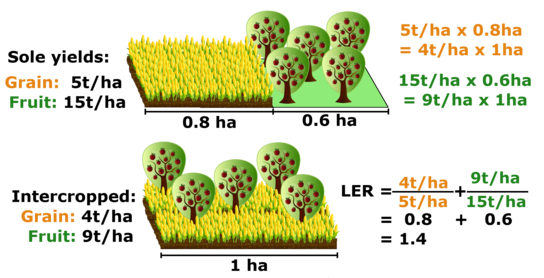Land equivalent ratio (LER) in agriculture refers to relative land required in area under monoculture or sole cropping to give the same yields as under polyculture or intercropping. The LER ratio refers to the ratio between comparative yield of each crop and tree species in agroforestry compared to the yield in a monoculture system of the same crop and tree species over same period of time. Can be used where a producer can obtain more than one yield in the same area 9.
Sustainable intensification of agriculture is required to meet future increasing food demand while reducing the agro-ecological footprint 10. Diversification of agricultural production systems enhances agro-ecological strategies like increasing biodiversity and higher crop protection.
Intercropping as a strategy increases agricultural productivity per unit of land by improving resource capture 10. Intercropping can be a guide to diversify agro-ecological systems by using leguminous crops and reducing on the use of mineral fertilizers 11.
In agroforestry, the LER serves as a productivity indicator by evaluating yields from crops and trees together in comparison to those from a monoculture cropping system 9. The integration of arable crops and trees have justified benefits such as improved soil fertility, protection against erosion and biodiversity 12. An LER greater than 1 indicates that production is higher in the agroforestry system compared to that in a monoculture system 9.
REFERENCES
1 Seserman, D.-M. in European Agroforestry Conference-Agroforestry as Sustainable Land Use, 4th. (EURAF).
2 Yu, Y., Stomph, T.-J., Makowski, D. & van der Werf, W. Temporal niche differentiation increases the land equivalent ratio of annual intercrops: a meta-analysis. Field Crops Research 184, 133-144 (2015).
3 Salehi, A., Fallah, S., Neugschwandtner, R. W., Mehdi, B. & Kaul, H.-P. Growth analysis and land equivalent ratio of fenugreek-buckwheat intercrops at different fertilizer types.
4 Jose, S. Agroforestry for conserving and enhancing biodiversity. Agroforestry Systems 85, 1-8 (2012).
